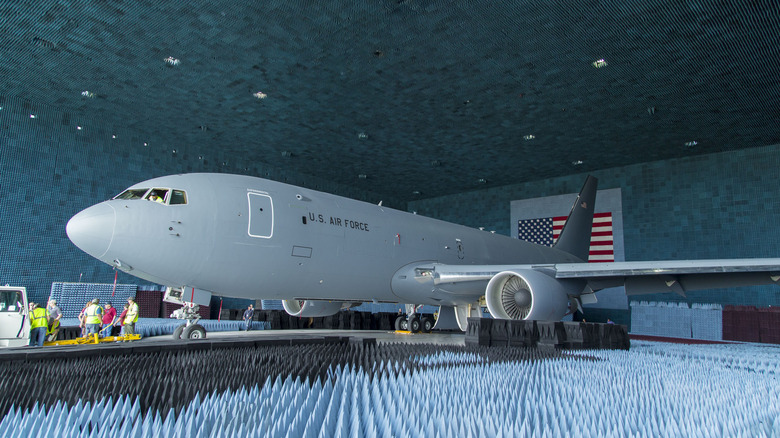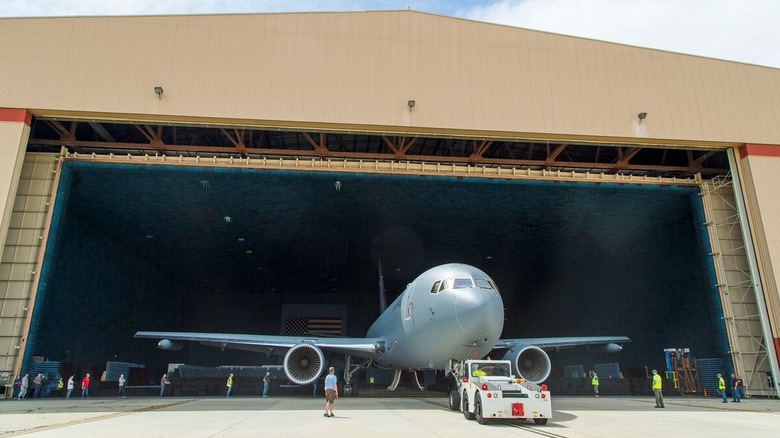Why The US Air Force Has The World's Largest Anechoic Chamber (And What Is It Used For)
Military technology often advances more rapidly than any other kind of tech, with new machines and facilities surpassing expectations and beliefs each time. In the late 80s, one such advance was the Benefield Anechoic Facility (BAF), which is the largest facility of its kind in the world. Hidden deep inside Edwards Air Force Base in California, this gargantuan building was complete in 1989 and is 264 feet long, 250 feet wide, and 70 feet tall. It's big enough to easily hold planes and satellites for testing. Special radar-absorbing materials line its walls to keep out interfering signals, making it the perfect place for sensitive testing.
The BAFs main purpose is simple but important: to test and improve aerospace systems in complete electromagnetic isolation. Engineers use the controlled conditions in this chamber to recreate real-world situations to test stealth technology, check radar signatures, or make sure communication system are fine tuned to perfection. This method helps keep military operations safe and reliable by mitigating the failure of the systems when they are used in real missions.
Technology is transforming the U.S. military all the time, and the BAF is a major testing facility for military technology. The facility is responsible for keeping the United States ahead of the curve when it comes to technology, ensuring the military is ready for any new threats that may emerge.
Inside BAF and its high tech upgrade
The BAF is an anechoic chamber, which is highly specialized testing room, designed to completely absorb electromagnetic signals and sound, stopping any reflections or echoes from occurring. Since it was developed, the BAF has received several upgrades that make it even more useful in today's ever-changing world of tech. One of the biggest improvement was the addition of an enormous turntable system to allow even bigger planes, satellites, machines, and other vehicles into the facility for testing. These new tools are highly important for applying military equipment in stringent ways to assess how well they can handle electronic warfare tactics.
A return of satellite testing to the BAF after five decades is one of the most exciting prospects for the facility. The achievement is indicative of a larger strategic shift to augment America's space operations. The facility is extremely important as it's one of the few places in the world where satellites and other space tech can be tested reliably and rigorously in a controlled setting.
While these adjustments highlight the changing times, they are also part of a master plan for the U.S. military to lead in this field. The incredible capabilities of the BAF, and the constant improvements it receives, help the U.S. stay at the top of the game in aerospace and defense technology.
America's key to aerospace superiority
The BAF is more than just a place to test things; it's an integral part of ensuring the U.S. military's tech is prepared for any threat. The standard HERO (Hazards of Electromagnetic Radiation to Ordnance) tests performed on legendary aircrafts, such as the B-1 Lancer and B-52 Stratofortress which is still flying today, are prime examples. The carefully-executed paces are crucial in ensuring the integrity of planes electronic and radar systems during real world environments.
Although the inception of the facility was to test planes, it is now more useful for more than aviation. As we become more and more reliant on space-based tech for things such as navigation and surveillance, the BAF will become an essential part of satellite testing. In these cases, the facility can make sure that essential systems function properly in certain environments. When we consider how fast space is being militarized, the importance of the BAF becomes more apparent.
As other countries enter the technological arms race and improve their electronic warfare arsenals, being ahead of the curve technologically is almost mandatory now. In the face of dealing with new and evolving threats, the BAF is an irreplaceable asset, and its reputation as an integral part of the U.S. military's air and space superiority will continue for some years to come.


